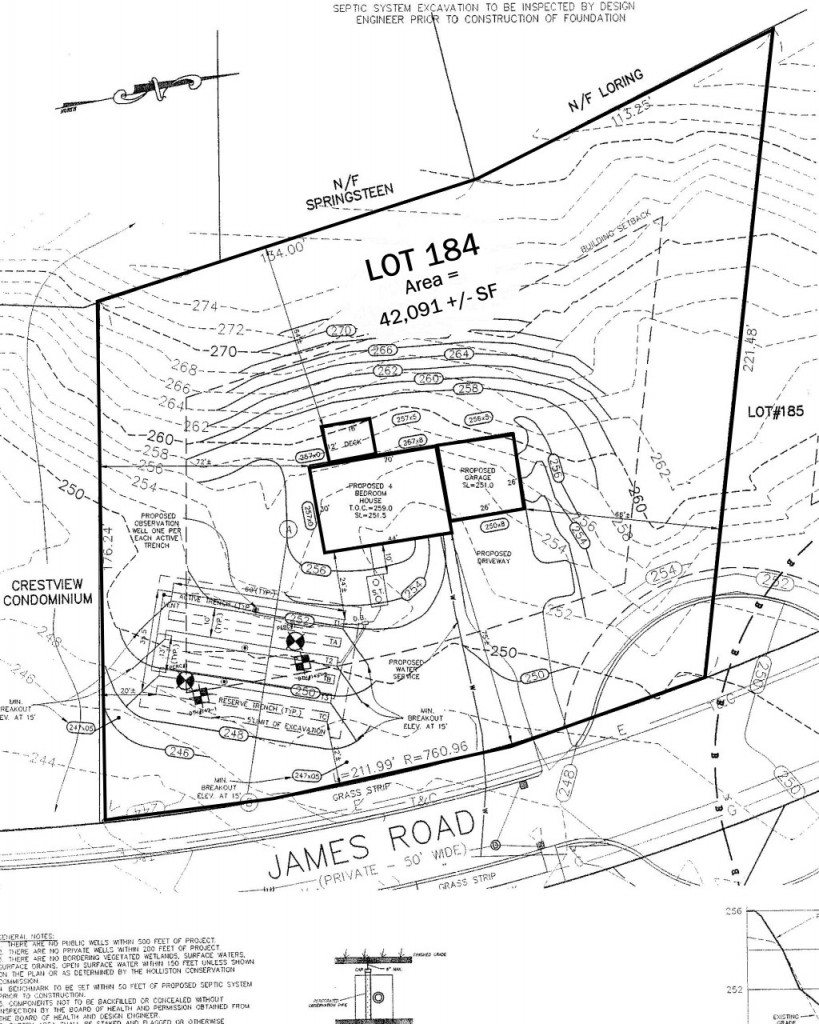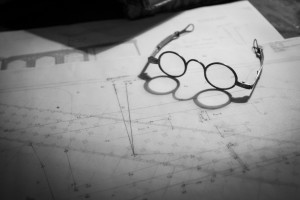
Initial documents: In part 1 I discussed the process of building a new home or renovation from the initial contact to the proposal and finally reaching an agreement. Part 2 will cover the documents that will be your responsibility as the property owner.

A plot plan shows all natural and man made features on any piece of property professionally surveyed by a civil engineer or land surveyor.
Plot Plan: Before getting started with the design process your architect will need to know if your project will fit on the property and meet all zoning requirements. For this a plot plan will be necessary. This is generated by a civil engineer and can cost north of $1,000. If you don’t already have one contact your building official at the town hall, he might already have one on file. A plot plan is a very important document when building a new home or adding an addition. It is basically an overhead view of your property and contains many symbols and abbreviations, but the important information your architect will need are any existing structures, property lines, any public easements, wetlands, and the locations of any existing underground utilities. If your town has a public utilities at the street, these will also be on the plot plan, as well as the location where they cross the property line. These utilities will be indicated as several confusing lines in the middle of the street. If you don’t see them don’t run out and pay for another survey. This likely means you will need a septic system and a well.

Test Data: An empty site for a for building a new home will need at least the following two soil tests and enough to get you started.
- The first, called a perc test will determine how permeable the soil is and aid in design of a septic system. This will only be necessary if a public sewer connection at the street is not available.
- The second test will determine the structural capacity of the soil and ultimately the type of foundation that will be required for your new home. If your property is in a development or has existing homes nearby there may already be test data available. Check with your local building official for the availability as well as whether or not he/she will require additional testing.
Renovations and additions will not likely need either test due to the existing nature. Testing has already been done.

Existing drawings: If building a new home these will not be necessary, if you are doing a renovation or addition, existing drawings (formerly known as blueprints) are not required but will be will save you a few dollars. If none are to be had your architect will have to measure the house, interior and exterior and then have plans drawn from scratch. This is time consuming and can take several days to a week. So if you have those drawings stashed away somewhere dig them out, it will save you money. However, before going through the task of re-drawing, a good architect will take a trip to the local building department and see what they might have on file from previous permitting, if any. Ensure he or she does this, or better yet go down yourself.

Budget: Not a document but a conversation that needs to happen early on, and will likely be one of the first questions asked by your architect. A project budget will provide a clear path and reliable reference that will eliminate assumptions leading to frustrations. Dave Ramsey, a financial expert who in my opinion offers the most sound and realistic advice says asking “how much will it cost to build a new home” is asking the wrong question. Your question should be around what you can afford, and any good architect (including yours truly) will get you as close to your wants as he can. We just need a budget to work with.
Residential clients typically have a rough idea of what they WANT to spend but not solid plan. The budget is important because it will give your architect a place to start the design and most importantly a limit to the design. Not having a budget is like trying to walk normally without shoe laces. It can work, but it will be frustrating and you won’t get far before you’re tripping all over yourself. Your budget will also be a point of reference for the architect’s fee, see previous post “What Does An Architect Charge & How They Structure Their Fee?” However, if you just cannot arrive at a budget, don’t let it delay your will to get started. Just tell your architect, he or she can assist you in arriving at a budget that meets your needs and fits your wallet. In these situations I will start the discussion by describing three levels of quality, high-end, middle or economical and each having a cost per square foot attached. This will then give my budget challenged clients a visual perspective and a place to determine what they can afford. It’s not ideal but it beats walking without shoelaces.
Next week part 3: The Fun Part
photos not by the author used with creative commons license